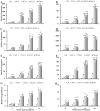The Ectopic Expression of the MpDIR1(t) Gene Enhances the Response of Plants from Arabidopsis thaliana to Biotic Stress by Regulating the Defense Genes and Antioxidant Flavonoids
- PMID: 39409562
- PMCID: PMC11478391
- DOI: 10.3390/plants13192692
The Ectopic Expression of the MpDIR1(t) Gene Enhances the Response of Plants from Arabidopsis thaliana to Biotic Stress by Regulating the Defense Genes and Antioxidant Flavonoids
Abstract
The Defective in Induced Resistance 1 (DIR1) gene, a member of the lipid transferase proteins (LTPs), plays a crucial role in plant defense against pathogens. While previous transcriptomic studies have highlighted the significant expression of citrus LTPs during biotic stress, functional annotations of LTPs in the Citrus genera remain limited. In this study, we cloned the Murraya paniculata DIR1 (MpDIR1(t)) gene and overexpressed it in Arabidopsis thaliana to evaluate its stress response mechanisms against biotic stress. The transgenic Arabidopsis lines showed fewer disease symptoms in response to Pseudomonas syringae (Pst DC3000) compared to wild-type Arabidopsis. Defense and pathogenesis-responsive genes such as PR1, PR4, PR5, and WRKY12 were significantly induced, showing a 2- to 12-fold increase in all transgenic lines compared to the wild type. In addition, the Pst DC3000-infected transgenic Arabidopsis lines demonstrated elevated levels of flavonoids and salicylic acid (SA), along with higher expression of SA-related genes, compared to the wild type. Moreover, all transgenic lines possessed lower reactive oxygen species levels and higher activity of antioxidant defense enzymes such as superoxide dismutase, peroxidase, and catalase under Pst DC3000 stress compared to the wild type. The up-regulation of defense genes, activation of the SA pathway, accumulation of flavonoids, and reinforcement of antioxidant defense mechanisms in transgenic Arabidopsis lines in response to Pst DC3000 underscore the critical role of MpDIR1(t) in fortifying plant immunity. Thus, MpDIR1(t) constitutes a promising candidate gene for improving bacterial disease resistance in commercial citrus cultivars.
Keywords: Arabidopsis; biotic stress; citrus; gene expression; salicylic acid; stress response mechanisms.
Conflict of interest statement
The authors declare no conflicts of interest.
Figures









Similar articles
-
Proteomics and functional analyses of Arabidopsis nitrilases involved in the defense response to microbial pathogens.Planta. 2016 Aug;244(2):449-65. doi: 10.1007/s00425-016-2525-3. Epub 2016 Apr 19. Planta. 2016. PMID: 27095107
-
Overexpression of F-Box Nictaba Promotes Defense and Anthocyanin Accumulation in Arabidopsis thaliana After Pseudomonas syringae Infection.Front Plant Sci. 2021 Jul 29;12:692606. doi: 10.3389/fpls.2021.692606. eCollection 2021. Front Plant Sci. 2021. PMID: 34394146 Free PMC article.
-
AtWRKY1 negatively regulates the response of Arabidopsis thaliana to Pst. DC3000.Plant Physiol Biochem. 2021 Sep;166:799-806. doi: 10.1016/j.plaphy.2021.06.044. Epub 2021 Jun 30. Plant Physiol Biochem. 2021. PMID: 34218208
-
Ethylene Response Factor ERF11 Activates BT4 Transcription to Regulate Immunity to Pseudomonas syringae.Plant Physiol. 2019 Jun;180(2):1132-1151. doi: 10.1104/pp.18.01209. Epub 2019 Mar 29. Plant Physiol. 2019. PMID: 30926656 Free PMC article.
-
Comprehensive Analysis of NAC Genes Reveals Differential Expression Patterns in Response to Pst DC3000 and Their Overlapping Expression Pattern during PTI and ETI in Tomato.Genes (Basel). 2022 Nov 2;13(11):2015. doi: 10.3390/genes13112015. Genes (Basel). 2022. PMID: 36360252 Free PMC article. Review.
Cited by
-
Integrated Transcriptome and Targeted Metabolome for Resolving Flavonoid Biosynthesis in Figs (Ficus carica Linn.).Biology (Basel). 2025 Feb 11;14(2):184. doi: 10.3390/biology14020184. Biology (Basel). 2025. PMID: 40001952 Free PMC article.
-
Optimizing processing methods for maximum bioactive retention: comparative metabolomic analysis of dried loquat (Eriobotrya japonica) flowers and their powdered extracts.Front Nutr. 2025 Aug 1;12:1637247. doi: 10.3389/fnut.2025.1637247. eCollection 2025. Front Nutr. 2025. PMID: 40823016 Free PMC article.
-
ROS Regulation and Antioxidant Responses in Plants Under Air Pollution: Molecular Signaling, Metabolic Adaptation, and Biotechnological Solutions.Antioxidants (Basel). 2025 Jul 24;14(8):907. doi: 10.3390/antiox14080907. Antioxidants (Basel). 2025. PMID: 40867806 Free PMC article. Review.
-
Integrated Transcriptomic and Metabolomic Analyses Reveal Key Antioxidant Mechanisms in Dendrobium huoshanense Under Combined Salt and Heat Stress.Plants (Basel). 2025 Jul 25;14(15):2303. doi: 10.3390/plants14152303. Plants (Basel). 2025. PMID: 40805650 Free PMC article.
References
-
- Carella P., Kempthorne C.J., Wilson D.C., Isaacs M., Cameron R.K. Exploring the role of DIR1, DIR1-like and other lipid transfer proteins during systemic immunity in Arabidopsis. Physiol. Mol. Plant Pathol. 2017;97:49–57. doi: 10.1016/j.pmpp.2016.12.005. - DOI
Grants and funding
LinkOut - more resources
Full Text Sources

